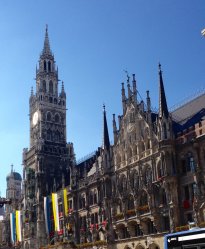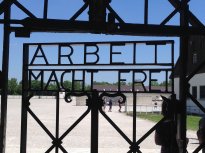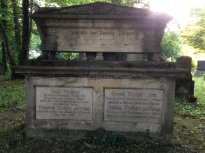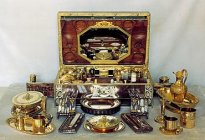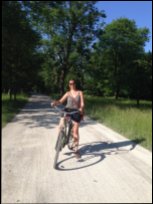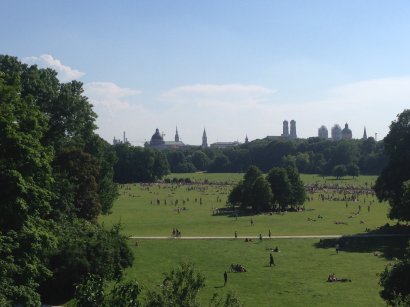Munich -- The Big City with a Small Town Attitude
Munich is often described as a "village of a million inhabitants". It is, on one hand, the headquarters of BMW and cutting edge technology, while, on the other, it still embraces the traditional markets, beerhalls, gingerbread architecture and deeply-rooted customs. It is not uncommon to see men and women walking casually in the streets wearing traditional lederhosen or dirndl skirts and talking on their mobile phone.
We were staying in the old town within a maze of pedestrian streets that centered around the Marionplatz or main plaza. Our first glimpse of this large square, lined with historic buildings and teeming with people, took our breath away. The New Town Hall, built in the 19th C. contains the famous glockenspiel to which tourists gather to watch three times daily. At these times, the bells play music while the figures perform the Cooper's Dance, which was originally performed in the square in the 16th century to commemorate the end of the plague.
Unbeknownst to us, our first full day in Munich happened to be a major religious holiday, the Corpus Cristi. We were forewarned by our B&B host that political dissenters often used large holiday gatherings to make their statement, that a number of protests were scheduled, mainly due to the fact that Obama was in Germany, and that there would be increased police presence in the city. We decided to spend the day away from the main squares and instead visit the Alte Pinakothek, or Art Museum of Old Masters. Along the way to the museum, we passed several streets lined with police vans and filled with young law enforcers ready for action. We also passed several churches that had conveniently placed loudspeakers outside on the nearby buildings so that every passerby could receive the message. It was quite surreal to walk the nearly deserted streets while choral music echoes off buildings and police forces quietly position themselves for action. As it turned out, we never came across any political gatherings or heard of any altercations between the police and its citizens.
We spent an hour or so perusing the mainly German, Dutch and Flemish masters for which the Alte Pinakothek museum is renowned. Again, I enjoyed most watching Talia discover the beauty and power of 16th to 18th century art and we had a few good conversations on the aesthetics, meaning and significance of specific pieces.
Later, we took the 30 minute train/bus trip to Dachau concentration camp. Our guidebook had warned us to prepare for an emotional experience. From the moment we walked through the iron gate with the infamous words "Arbiet Macht Frie", the tragedy of events that took place here (and all concentration camps) during WW2 overwhelmed us. The museum does an excellent job of giving the timeline of events that led to the formation, operation and ultimate disintegration of Dachau. The movie and photos show real people...with faces...and families. We saw, in the re-created barracks and in photos and artifacts, the cruel and inhumane conditions to which people were subjected. And finally, when we saw the "gas " room and ovens that disposed of bodies, we were sickened by the whole experience...
It is ironic that earlier in the day we were celebrating the beautiful side of humanity as expressed through art, and now we were witness to the dark and horrific side. People being treated worse than animals, losing families, and perhaps most terrible of all, losing hope--it was worse than a nightmare. It should be mandatory for every human being on this earth to be exposed to the reality of concentration camps, so that this will never happen again. Sadly, fanatacism, human indignity and senseless killing of innocent people continues to occur. Humanity does not seem to learn from its past.
After returning to Munich, and in great need of (liquid) fortification, we had a beer and a great meal at a well-known beer garden. Pschorr Brauerie, with its patio encompassing a large leafy plaza on a quiet street, is considered one of the top ten breweries to visit in Munich. In addition to producing its own beer, its menu is created from locally-produced meats and vegetables. It was a memorable meal...as it turns out, in more ways than one.
Talia, seeking something completely different from the tourist scene, wanted to wander through the back streets in search of an old cemetery that might provide opportunities for unique photos. We easily found the desired cemetery in the middle of a quiet residential area. It was early evening and the sun was starting to cast long shadows from the many gnarly trees, statues and tombstones. As we wandered up and down the pathways, we noticed that many grave sites had been abandoned and the inscriptions were unreadable (we found out later that grave sites were rented, and if the family and future generations did not continue to pay, the spot was left to deteriorate). With the angle of the sun and the variety of shapes, sizes and conditions of the tombstones and foliage, this was clearly perfect material for fabulous photos.
We noticed an older man standing in front of a more elaborate site, one that was relatively new with a clearly-etched inscription on the stone. It contained 3 burials...all with the name of Pschorr. We quickly realized that it was the same name as the Brewery where we ate dinner. The man then explained (in Englisih!) that the oldest tombstone at this site was the founder of the Brewery. After some exclamations about the coincidence of having just eaten there, he told us that he was in the cemetery to search for his ancestors and had actually just found the site of one.
Standing in the deepening shadows, surrounded by the eerie shapes of stonework and trees, and speaking to a complete stranger about history and ancestry, it was a strange but unique encounter that we won't easily forget.
The Residenz, former home to the Bavarian house of Wittelsberg in the 18th century, is the largest city palace museum in Germany and visitors can explore its architecture, opulent baroque room decor, and royal treasury. We spent a few hours in the Treasury drooling over the priceless collection of jewelry, royal crowns, dishes and ornaments gilded in gold and covered in precious stones. The most curious item was a unique travel chest, a gift for the queen Marie Louise from Napoleon. It essentially contained everything one would need while on the road--cosmetics, grooming utensils, picnic supplies, sewing implements and more--all ingeniously stored in drawers and secret compartments that were ornately decorated with paintings and jewels. We both agreed that, had we lived in that era, this would have been high on our Christmas list.
There are many more beautiful historic buildings in Munich, many of which had to be rebuilt after WW2. We could have spent days touring these, but instead we chose the "off-the-tourist-path" to finish our time in the city. It had been really hot and muggy and after our early walkabout in town, we decided to rent bicycles and pedal a short distance away to Munich's "English Garden".
This green space covers a huge part of the city. Several tributaries of the main river have been diverted through it, feeding a large lake in the park's center. The park also contains open fields (filled with hundred of sunbathers), kilometers of forest paths, clothing-optional river access, a historical monument, a pagoda and most importantly, two beer gardens. After a glorious ride for a few hours along the tree-lined bike paths, we stopped for a beer at the lake's edge. A cool breeze filled the air as we sipped our beer and watched the ducks and swans conveniently swim by in hopes of a meal. It was the perfect way to end our day...
Before we took the train north to Berlin (with planned stops in Nuremberg and Bamberg), we went east two hours to Salzburg, Austria for the day. I had read it was an absolute beautiful city and it was just too close for us to ignore. We also could purchase a cheap 2-for-1 train ticket.
The city sits at the base of the towering Alps and the old town lies along the banks of the Salzach river, with its most prominent feature, the Hohensalzburg Fortress, perched on a cliff above. Most visitors come to experience the Mozart phenomena (this being the place he was born and grew up) and the touristy Sound of Music tours.
The town was very walkable, so we decided to do a self-guided tour in order to cover the most important sites. We tried to avoid as much as possible the places where the tour bus crowds were congregating. And we had no interest in participating in the Sound of Music tours--we were even passed by a bike tour that had the movie's theme song blaring out a speaker attached to the leaders bike.
When we got to Mozart's house and "museum" and discovered that the cost to enter was pricey, we headed directly to the "elevator" (not the funicular and its very long lineups) to get to the top of the cliff in order to do a 30 minute walk along the cliffs and through the forest to the fortress. We escaped the crowds...again! The walk offered amazing views and a respite from the heat. And the tour of the fortress took us to the top of its tower, where we had commanding views of the entire city and the majestic alps a short distance away. It was indeed a picturesque town.
Since we first arrived in the country, we had been noticing that the Germans love their stag and stagette parties. On many occasions a group of young men or women had passed us in the streets, wearing matching Tshirts or tiaras etc. with the bride or groom in silly costumes, on their way to drink and party. It also seems acceptable to carry and drink beer openly in public so most often the participants were well into their celebration.
We were given the opportunity to experience this fondness for drunken displays first hand. For most of our train ride back to Muncih, we were loudly serenaded by a group of beer-toting guys, already quite inebriated. They had a small repertoire of silly "tying-the-knot" songs, that they belted out...ad nauseum! We watched one sheepish train official try to settle them down, without success. With a lack of air conditioning and the obnoxious ranting at the back of the train car, it was an excruciatingly long train ride. Funny enough, it took a stern-looking woman official to put an end to the ranting, and shortly after that, they got off the train.
Photos
- The New Town Hall Bell tower performing for the crowds belwo
- banquet room in The Residenz
- image
- Munich Graveyard
- image
- Dachau Concentration Camp--Translation: Welcome to Death
- Dachau Concentration Camp
- Dachau--the long walk to the Death Chambers
- The New Town Hall in Munich
- 19th century travel set
- Munich's "English Garden"
- Enjoying a ride in the park
- Salzburg Old Town
- Hohensalzburg Fortress
- "I'm Stuck!"in Munich's New Town Hall
- The Original "Hofbrauhaus" in Munich
- Selfie at a Beer Garden
- Locals playing in the city's main river
